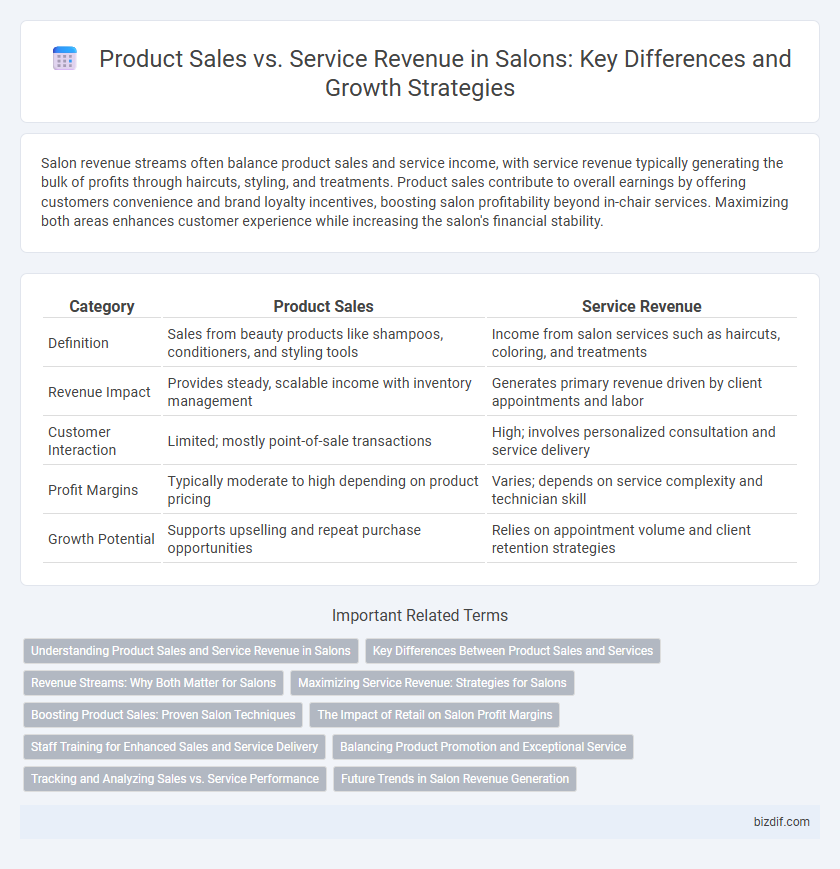Salon revenue streams often balance product sales and service income, with service revenue typically generating the bulk of profits through haircuts, styling, and treatments. Product sales contribute to overall earnings by offering customers convenience and brand loyalty incentives, boosting salon profitability beyond in-chair services. Maximizing both areas enhances customer experience while increasing the salon's financial stability.
Table of Comparison
| Category | Product Sales | Service Revenue |
|---|---|---|
| Definition | Sales from beauty products like shampoos, conditioners, and styling tools | Income from salon services such as haircuts, coloring, and treatments |
| Revenue Impact | Provides steady, scalable income with inventory management | Generates primary revenue driven by client appointments and labor |
| Customer Interaction | Limited; mostly point-of-sale transactions | High; involves personalized consultation and service delivery |
| Profit Margins | Typically moderate to high depending on product pricing | Varies; depends on service complexity and technician skill |
| Growth Potential | Supports upselling and repeat purchase opportunities | Relies on appointment volume and client retention strategies |
Understanding Product Sales and Service Revenue in Salons
Product sales in salons refer to the retail of haircare and skincare products that clients purchase for home use, generating a steady revenue stream beyond appointment services. Service revenue is derived from in-salon treatments such as haircuts, coloring, styling, and spa services, which are often the primary income source for salons. Analyzing the balance between product sales and service revenue helps salons optimize profitability by enhancing client experience and encouraging repeat purchases.
Key Differences Between Product Sales and Services
Product sales in salons involve tangible goods such as shampoos, conditioners, and styling tools, generating immediate revenue through one-time transactions. Service revenue stems from offering haircuts, coloring, or spa treatments, relying on skilled labor and repeat customer visits for sustained income. Key differences include inventory management for products versus appointment scheduling for services, with products often having variable profit margins influenced by wholesale costs and services depending heavily on staff expertise and customer experience.
Revenue Streams: Why Both Matter for Salons
Product sales and service revenue are both crucial revenue streams for salons, each contributing uniquely to overall profitability. Product sales offer higher profit margins and enable customer retention beyond salon visits, while service revenue drives steady cash flow through appointments and personalized experiences. Balancing these streams helps salons achieve sustainable growth and diversify income sources.
Maximizing Service Revenue: Strategies for Salons
Maximizing service revenue in salons involves implementing targeted upselling techniques and personalized service packages that increase client spend per visit. Leveraging appointment scheduling software to optimize booking efficiency and minimize downtime boosts service throughput. Training staff to enhance client engagement and retention fosters repeat visits, directly driving higher service-based income compared to product sales.
Boosting Product Sales: Proven Salon Techniques
Boosting product sales in salons hinges on strategic merchandising and personalized recommendations that leverage customer preferences and service history. Effective techniques include training staff to provide tailored product demonstrations and integrating product education into service conversations, which increases client trust and purchase likelihood. Implementing loyalty programs and exclusive promotions further drives repeat product purchases, enhancing overall salon revenue beyond service fees.
The Impact of Retail on Salon Profit Margins
Retail product sales significantly enhance salon profit margins by offering high-margin revenue streams beyond service fees. Salons that effectively promote and integrate retail products can increase overall earnings by up to 30%, leveraging brand loyalty and customer convenience. Optimizing inventory and product placement directly boosts average ticket size and repeat customer visits, solidifying long-term profitability.
Staff Training for Enhanced Sales and Service Delivery
Staff training in salons directly boosts product sales and service revenue by equipping employees with in-depth knowledge of products and techniques, enabling personalized customer recommendations that increase purchase rates. Comprehensive training enhances staff confidence and service efficiency, resulting in higher client satisfaction and repeat visits, which drive sustained revenue growth. Investment in continuous education programs ensures employees stay updated on industry trends, fostering an expert team that maximizes both retail opportunities and quality service delivery.
Balancing Product Promotion and Exceptional Service
Balancing product promotion and exceptional service in a salon maximizes overall revenue by driving both product sales and service bookings. Encouraging clients to purchase high-quality haircare products aligned with their treatment plans enhances customer satisfaction and loyalty. Expert staff training ensures personalized service that not only boosts repeat visits but also naturally supports product recommendations.
Tracking and Analyzing Sales vs. Service Performance
Tracking product sales versus service revenue enables salons to identify high-performing areas and optimize inventory and appointment scheduling. Analyzing detailed sales data and customer preferences helps tailor marketing strategies and enhance overall profitability. Regular performance reviews facilitate informed decision-making for pricing, promotions, and service offerings.
Future Trends in Salon Revenue Generation
Future trends in salon revenue generation highlight a growing emphasis on service customization and experiential offerings that drive higher service revenue. Product sales are expected to evolve through personalized beauty solutions and subscription-based models, enhancing customer retention. Integration of digital tools such as AI-driven consultations and e-commerce platforms will further optimize the balance between product sales and service revenue streams.
Product Sales vs Service Revenue Infographic

 bizdif.com
bizdif.com